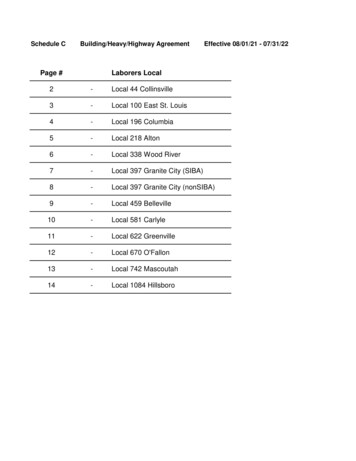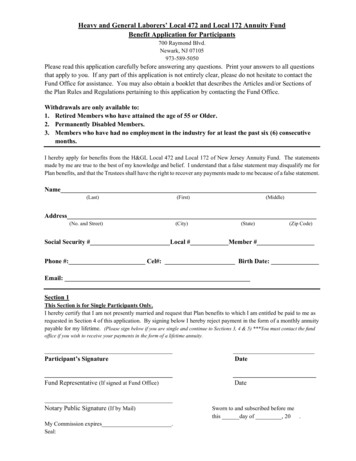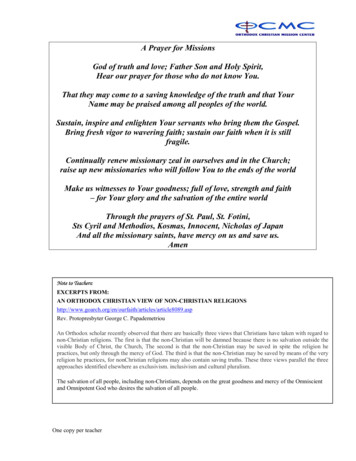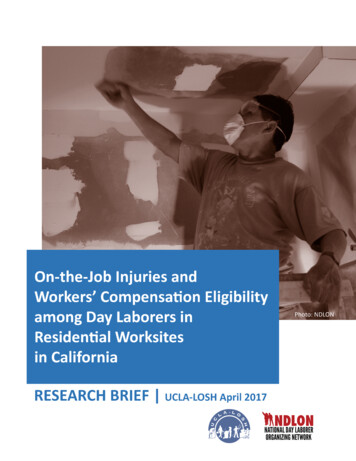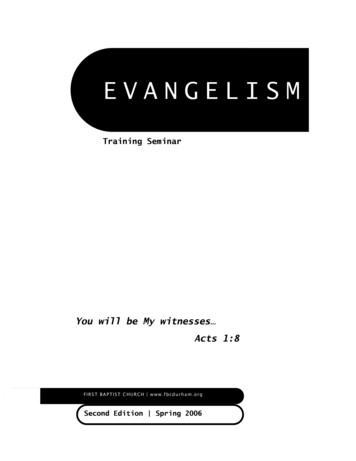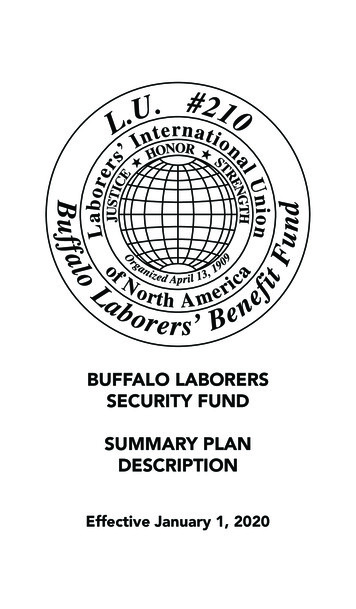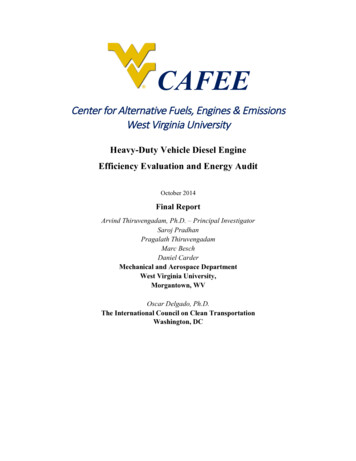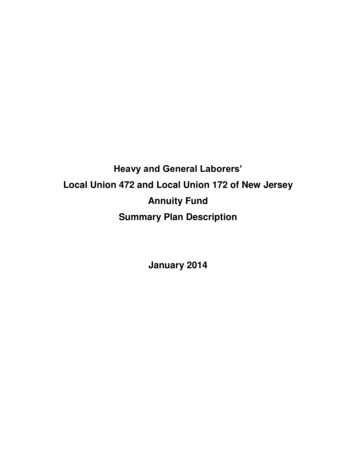
Transcription
Heavy and General Laborers’Local Union 472 and Local Union 172 of New JerseyAnnuity FundSummary Plan DescriptionJanuary 2014
Heavy and General Laborers’Local Union 472 and Local Union 172 of New JerseyAnnuity Fund700 Raymond BoulevardTelephone: 973-589-5050Newark, NJ 07105Fax: 973-589-3276BOARD OF TRUSTEESUnion TrusteesEmployer TrusteesAntonio OliveiraCo-ChairmanBusiness ManagerLIUNA Local Union 472700 Raymond BoulevardNewark, NJ 07105Phone: 973-589-5050; Fax: 973-589-0582J. Fletcher Creamer, Jr.Co-ChairmanChief Executive OfficerJ. Fletcher Creamer & Son101 East BroadwayHackensack, NJ 07601Phone: 201-488-9800; Fax: 201-488-4977Charles MosierLIUNA Local Union 472254 Mountain Avenue, Suite 3AHackettstown, NJ 07840Phone: 908-684-9580; Fax: 908-684-9582Franklyn GrossoSecretaryLaFera Inc.93 Arverne RoadWest Orange, NJ 07052Phone: 201-245-4500Raymond M. PocinoPresident-Emeritus, Local Union 172LIUNA Vice President and Eastern RegionalManagerP.O. Box 554Cranbury, NJ 08512Phone: 609-860-2887; Fax: 609-860-2845Jack Kocsis, Jr.Chief Executive OfficerACCNJRaritan Center Plaza II, Suite A-1991 Fieldcrest AvenueEdison, NJ 08837Phone: 732-225-2265; Fax: 732-225-3105Donald HibbsLIUNA Local Union 472700 Raymond BoulevardNewark, NJ 07105Phone: 973-589-5050; Fax: 973-589-0582Jeffrey S. WatersPresidentWaters and Bugbee, Inc.75 South Gold DriveHamilton, NJ 08691Phone: 609-584-1100; Fax: 609-584-2200Anthony CapaccioPresident and Business ManagerLIUNA Local Union 172604 Bordentown RoadTrenton, NJ 08610Phone: 609-291-9100; Fax: 609-291-0158Richard L. FormanForman Consulting181 Golf Hill RoadHonesdale, PA 18431Phone: 570-251-7737General ManagerCharles B. O’NeillLegal Co-CounselZazzali, Fagella, Nowak, Kleinbaum &Friedman, P.C.Susanin, Widman & Brennan, P.C.ConsultantThe Segal Company
TO ALL PARTICIPANTSIt is with great pleasure that we present you with this Guide describing your Annuity Planbenefits as of January 2014.In this Guide you’ll find a description of the eligibility requirements for participation, the benefitsto which you’re entitled and the procedures you should follow to obtain benefits provided by theFund. If you want more detailed information about the Plan, you may contact the Fund Office fora copy of the rules and regulations for the Plan.We strongly urge you to read the Guide carefully and familiarize yourself with the features of thePlan. We also recommend that you share this booklet with your family to protect their interestsand that you keep it handy for future reference.We are very proud of the Annuity Plan and the additional funds it provides for you at retirement.If you need any assistance or information, please call the Fund Office at 973-589-5050. Wethank you for your support and look forward to continuing to provide savings for your retirementyears.Sincerely,Board of Trustees
ANNUITY PLANCONTENTSINTRODUCTION . 1PARTICIPATING IN THE PLAN . 2WHO CAN PARTICIPATE . 2WHEN PARTICIPATION BEGINS . 2DESIGNATING YOUR BENEFICIARY . 2YOUR INDIVIDUAL ACCOUNT IN THE PLAN . 4VALUATION DATE . 4HOW YOU EARN THE RIGHT TO YOUR INDIVIDUAL ACCOUNT . 5100% VESTING. 5YOU MAY NOT PLEDGE YOUR ACCOUNT . 5LOANS–BORROWING MONEY FROM YOUR ACCOUNT IN THE PLAN . 6LOAN PURPOSE . 6LOAN LIMIT . 7INTEREST . 7REPAYMENT . 7LOAN DEFAULT . 8RECEIVING BENEFITS FROM THE PLAN . 9AMOUNT OF YOUR BENEFIT . 9IF YOU RETIRE. 9IF YOU REACH NORMAL RETIREMENT AGE . 9IF YOU LEAVE THE INDUSTRY, MOVE TO ANOTHER PART OF THE COUNTRY ORENTER MILITARY SERVICE. 10IF YOU BECOME DISABLED . 10FORMS OF BENEFIT PAYMENT.11SPOUSE’S CONSENT TO THE LUMP SUM FORM OF BENEFIT . 12SMALL BENEFIT PAYMENT . 12QUALIFIED DOMESTIC RELATIONS ORDERS (QDROS). 12CONCERNING TAXES ON YOUR BENEFITS .14
AT EARLY WITHDRAWAL . 14STANDARD WITHHOLDING . 14ROLLING OVER YOUR ACCOUNT TO AN IRA OR ANOTHER PLAN . 15SURVIVOR BENEFITS .16BEFORE YOU ARE RECEIVING BENEFITS . 16WHILE YOU ARE RECEIVING BENEFITS . 17APPLYING FOR YOUR BENEFITS .18IF YOUR APPLICATION IS DENIED . 18APPEALING A DENIAL OF BENEFITS . 19YOUR RIGHTS UNDER THE UNIFORMED SERVICES EMPLOYMENT ANDREEMPLOYMENT RIGHTS ACT OF 1994 (USERRA) . 21PENSION BENEFIT GUARANTY CORPORATION (PBGC) . 22HOW BENEFITS CAN BE DELAYED . 22ASSIGNMENT OF BENEFITS . 23COMPLIANCE WITH FEDERAL LAW . 23RECOVERY OF OVERPAYMENT . 23YOUR DISCLOSURES TO THE PLAN . 24PLAN INFORMATION .25OFFICIAL PLAN NAME . 25EMPLOYER IDENTIFICATION NUMBER . 25PLAN NUMBER . 25TYPE OF PLAN . 25PLAN ADMINISTRATOR . 25PLAN ADMINISTRATION . 26FUNDING MEDIUM AND BENEFITS . 26PARTICIPATING EMPLOYERS . 26AGENT FOR SERVICE OF LEGAL PROCESS . 26PLAN YEAR . 27PLAN ADMINISTRATOR’S AUTHORITY . 27PLAN TERMINATION OR AMENDMENT . 27MAXIMUM CONTRIBUTIONS . 28RIGHTS AND RESPONSIBILITIES . 28YOUR RIGHTS UNDER THE EMPLOYEE RETIREMENT INCOME SECURITY ACT(ERISA) .29
RECEIVE INFORMATION ABOUT YOUR PLAN AND BENEFITS . 29PRUDENT ACTIONS BY PLAN FIDUCIARIES . 30ENFORCE YOUR RIGHTS. 30ASSISTANCE WITH YOUR QUESTIONS . 31
Se tiver qualquer deficuldade em compreender qualquer parte deste livrete, por favor dirijaqualquer pergunta ao Director Geral, Heavy and General Laborers’ of New Jersey Annuity Plan.Telefone 973-589-5050. O horario do escritorio: Segunda a Sexta-feira: 9:00 a.m. – 5:00 p.m.This Guide, or Summary Plan Description, contains highlights of the retirement benefitsprovided by the Heavy and General Laborers’ Local Union 472 and Local Union 172 of NewJersey Annuity Plan. It doesn’t change the official rules and regulations in the official Plandocument or other documents, including trust agreements and the collective bargainingagreements establishing the Plan. Rights to benefits are determined only by referring tothe full text of official Plan documents (available for your inspection at the Fund Office)or by official action of the Board of Trustees. If there is any conflict between the terms ofthe official rules and regulations of the Annuity Fund or the Plan it has adopted and thisSummary Plan Description, the official rules and regulations shall control.The Board of Trustees intends to continue the benefit programs described in this Guideindefinitely. Nevertheless, it reserves the right, subject to the provisions of any pertinentcollective bargaining agreement, to terminate or amend any or all of the Fund's benefitprograms in whole or in part at any time in the future. The Plan may be terminated by the Boardof Trustees when there is no longer in effect an agreement between an Employer and theHeavy and General Laborers' Local Union 472 and Local Union 172 of New Jersey requiringpayment to the Fund.If any questions concerning eligibility for benefits arise, the Trustees have sole and exclusiveauthority to resolve the issue. The Trustees’ decisions are final and binding.
INTRODUCTIONThe Plan was established on September 1, 1980 (originally the “Defined Contribution Plan”)under collective bargaining agreements made between participating employers and the Heavyand General Laborers’ Local 472 and Local 172 of New Jersey.A Board of Trustees, which consists of an equal number ofrepresentatives of the Union and representatives of the employers,administers the Fund. Their names and addresses are listed on theThe Plan is funded byemployer contributions.You are not required orpermitted to contribute to thePlan.first page of this section. They serve without any compensation. TheFund is a separate trust fund that was established for the purpose of paying benefits providedby the Plan.All contributions to the Plan are made by employers according to the terms of their collectivebargaining agreements with the Union. You are not required, nor are you permitted, to makecontributions to the Plan.The Plan may be amended or changed by the Board of Trustees. If it is changed, you will benotified. You should keep any notices of Plan changes with thisbooklet.Moving?Because the Board of Trustees will be communicating with you inwriting, you should notify the Fund Office as soon as you change youraddress.1Let the Fund Office know ifyou change your address.
PARTICIPATING IN THE PLANWHO CAN PARTICIPATEIn general, you are a participant in the Plan if you are an employee working for an employer thatis required to contribute to the Plan under the terms of a collective bargaining agreement withLaborers’ Local 472 or Local 172. You are also a participant if contributions are made on yourbehalf because you are a full-time salaried employee of: Local Union No. 472 or No. 172 of the Laborers InternationalUnion of North America, AFL-CIO; The Heavy and General Laborers’ Welfare Fund of New Jersey; The Heavy and General Laborers’ Locals 472 and 172 PensionFund;Participant means thatcontributions are made onyour behalf because you areemployed by a contributingemployer or by one of thePlans of the Union. The Heavy and General Laborers’ Locals 172 and 472 S.E.T. Fund; or The Heavy and General Laborers’ Locals 472 and 172 Group Legal Service Fund.As a participant, you will receive a statement from the Fund Office at least once a year showingthe amount of employer contributions that have been made on your behalf in the previous yearand the value of your individual account in the Plan.WHEN PARTICIPATION BEGINSYour participation begins when the Fund Office first receives contributions that your employer isrequired to make to the Plan on your behalf.DESIGNATING YOUR BENEFICIARYYou may designate a beneficiary to receive your account in the Plan in case you die before youreceive it. The Fund Office will provide you with a form to designate your beneficiary. You mayalso change your beneficiary at any time. The change will be effective at the time the FundOffice receives your new beneficiary designation form. If you are married or in a civil union, yourspouse or spousal equivalent is entitled to receive 50% of your account upon your death or youmay name your spouse or spousal equivalent to receive 100% of your account.2
If you die before you retire and you do not name a beneficiary or your beneficiary dies beforeyou, the Plan will pay your individual account as follows: If you are married or in a civil union at the time of your death, your spouse or spousalequivalent will generally receive your individual account in the form of a single life annuity.Your spouse or spousal equivalent can reject this form of payment and elect a lump sumor annual payments in equal installments, not in excess of 10 years. If you are not married or not in a civil union, your individual account will be paid to theExecutor or Administrator of your estate.Spousal Equivalent. The Plan recognizes a member’s civil union partner or same-gendermarriage partner as a “spousal equivalent.” To qualify as a spousal equivalent, the relationshipmust have been entered into in a state that licenses or registers civil unions or same-gendermarriages and the State of New Jersey must recognize the relationship as equal to a NewJersey civil union.Spouse. The term “spouse” or “surviving spouse” means an individual who is legally married toyou and who is treated as a spouse under federal law.3
YOUR INDIVIDUAL ACCOUNT IN THE PLANYour individual account is set up at the end of the first calendar year that the Fund receivescontributions on your behalf. “Individual account” describes the amount of money you wouldreceive from the Plan if you were entitled to receive a payout at that time.Your individual account is made up of: All of the contributions that are received on your behalf; plus Your proportionate share of interest earned and appreciation oninvestments of the Plan as of the last valuation date; minus A uniform share of the expenses of operating the Fund.Your individual accountequals:Contributions or -EarningsChange in valueExpensesYour account grows when your employer makes additionalcontributions, your account earns interest and the value of your account’s investments grows.The value of your account may decrease, however, if the value of your account’s investmentsdecreases. Your account will also decrease slightly by absorbing a uniform share of theexpenses of operating the Fund. If your account has a small balance and is inactive, however, itcan be decreased to zero if administrative charges to the account exceed your account’searnings.VALUATION DATEThe valuation date is the last business day of each calendar month. That is the date when thevalue of your individual account is determined. On that date, all of the factors that affect thevalue of your individual account – contributions, investment income, gains or losses andoperating expenses – are added to or subtracted from the value of your individual account asdetermined at the previous valuation date. You will receive a statement of your individualaccount value within six months after the end of each year that you are a participant in the Plan.4
HOW YOU EARN THE RIGHT TO YOUR INDIVIDUAL ACCOUNT100% VESTINGYou are always vested in – or have earned the right to – 100% of any contributions youremployer makes to your individual account plus earnings, minus your individual account’s shareof the Plan’s expenses.Your individual account is not available to you at any time you wish,but may be distributed to you under the rules explained in the sectionsabout receiving your individual account that follow.Vesting means that youhave earned the right to yourindividual account.You should be aware that if your account has a small balance and is inactive, it can bedecreased to zero if administrative charges to the account exceed your account’s earnings, sothat you would be vested only in a zero-balance account and would not receive a benefit fromthe Plan.YOU MAY NOT PLEDGE YOUR ACCOUNTAlthough you vest in your employer’s contributions immediately, you may not pledge yourindividual account as security for a loan or any other purpose. In addition, your account is notsubject to the claims of your creditors in legal proceedings, including bankruptcy or insolvencymatters. The Employee Retirement Income Security Act of 1974 (ERISA), the federal law thatgoverns your Plan, prohibits you from pledging your account and prohibits creditors from makingclaims against your account.5
LOANS–BORROWING MONEY FROM YOUR ACCOUNT IN THE PLANAfter contributions have been made to your individual account for three consecutive years, youmay borrow money from your individual account in the Plan.For Example:Luis began working in 2008 and the Fund Office began receiving contributions from hisemployer on August 1, 2008. The Fund Office set up an account for Luis onDecember 31, 2008. Luis continued working and the Fund Office continued to receivecontributions from his employers on his behalf during 2009 and 2010. Luis may borrowfrom his account as early as January 1, 2011.If you are married, your spouse must consent in writing to the loan. Ifyou are in a civil union or same-gender marriage, you do not need yourspousal equivalent’s consent to obtain a loan.To be eligible for a loanfrom the Plan, contributionsmust have been received onyour behalf for threeconsecutive years.LOAN PURPOSEYou may take a loan from your account for the following reasons: Medical expenses of 500 or more for you or your dependentsthat are not reimbursed by the Heavy and General Laborers’ ofNew Jersey Welfare Fund; Educational expenses beyond the high school level for you orYour home must be yourprimary residence forpurposes of Plan loans. Youmay receive a homepurchase loan only oncefrom the Plan.your dependents; Home improvement, home repairs or refinancing for your primary residence costing aminimum of 2,500; Home purchase expenses only one time for the purchase of your primary residence; Funeral expenses for your spouse, spousal equivalent, child, parent or parent-in-law; Expenses to prevent you from losing your primary residence due to foreclosureproceedings; Expenses to prevent you from being evicted from your principal residence or to assist youin obtaining a new principal residence due to eviction;6
Expenses to obtain a new principal residence or to renovate a principal residence, or toreplace necessary basic household furnishings or belongings, which have been destroyeddue to an Act of God; Expenses to pay federal and/or state taxes owed by you when an official notification fromthe IRS or the State has requested payment from you for such taxes owed.LOAN LIMITThere is a limit on the amount of your outstanding loan balance. The total of your outstandingloans from the Plan may not exceed the lesser of: 50% of the total balance of your individual account; or 50,000 (reduced by the excess of the highest outstanding balance of all loans during theone-year period).INTERESTYou must pay interest on your loan. The interest rate will be equal to the prime rate plus onepercent that was in effect on January 1 of the calendar year that your loan was approved. TheTrustees determine the interest rate annually on January 1 and the rate is effective throughDecember 31 of the same year for any loans you receive during that period. The interest ratewill be effective for the life of your loan. Beginning on loans issued after July 1, 2007, interestpayments will be added to your individual account and not to the total investment yield of allaccounts.REPAYMENTTo obtain your loan, you must sign a promissory note, which is an agreement to repay yourloan. Loans are repaid in amortized level quarterly payments due each January 1, April 1,July 1, and October 1. Your loan and all accrued interest must be entirely repaid within a fiveyear period. However, if the loan is for the purchase of your home (your primary residence), itmust be repaid within a 10-year period. You must send your loan payments by check or moneyorder to the Fund Office in accordance with the terms of your loan.7
You are not required to make loan payments while on active military duty. Loan repayments aresuspended during military service leave under the Uniformed Services Employment andReemployment Rights Act of 1994 (USERRA).If you have an outstanding loan balance at the time your account isdistributed to you, there will be an adjustment to your account balancefor the outstanding loan balance and any interest that is due beforeyour account is paid to you. However, the outstanding loan balance willFive years is the maximumrepayment period. However,you have 10 years to repayif the loan is for thepurchase of your home.be considered part of your individual account that you receive forincome tax purposes and it will be included in the taxable income that is reported to you and tothe Internal Revenue Service as a taxable distribution. See the section Concerning Taxes onYour Benefits on page 14.LOAN DEFAULTYou’re considered to have defaulted on your loan if you fail to make a scheduled payment bythe end of the calendar quarter following the quarter in which payment was due. If you defaulton a loan payment, your outstanding balance plus any accrued interest will be considered ataxable distribution.If you default on your loan, you will not be eligible to receive another loan. This lifetime ban onno further loans went into effect on loans that defaulted on or after January 1, 2004. In addition,if your promissory note is not sufficient to satisfy your outstanding loan balance, the Trusteesmay take any legal action necessary to enforce repayment of the loan, including any accruedinterest due. You may be responsible for the costs that the Trustees incur to collect the loan.Please contact the Fund Office if you need a loan application form.8
RECEIVING BENEFITS FROM THE PLANIn general, you can receive a distribution of your benefits from the Plan when you: Retire, Reach Normal Retirement Age, Leave the industry, move to another part of the country or enter military service, or Become disabled.AMOUNT OF YOUR BENEFITTo determine the amount you will receive from the Plan when you receive a distribution:Start with:The value of your individual account as of the last valuation date;Subtract:Any outstanding loans and accrued interest that you owe that has not alreadybeen subtracted from the account balance; andAdd:All contributions received on your behalf and all loan repayments made since thelast valuation date.IF YOU RETIREIn general, when you reach age 55 and retire, you are eligible toreceive the amount in your individual account. You must prove that youare retired by showing that you are receiving a pension from the Heavyand General Laborers’ of New Jersey Pension Fund.You are retired if you havecompletely withdrawn fromemployment as a laborerand you are receiving apension from the Heavy andGeneral Laborers’ PensionFund.You may also leave your individual account in the Plan and withdraw itat a later date, but not later than April 1 of the year after the year in which you reach age 70½.IF YOU REACH NORMAL RETIREMENT AGEIf you reach Normal Retirement Age and elect to receive a distributionof your account, it will be distributed to you immediately. You do notneed to be receiving your pension in order to receive your accountbalance at Normal Retirement Age.9Normal Retirement Age isthe later of the date youreach age 65 or the fifthanniversary of yourparticipation in the Plan.
IF YOU LEAVE THE INDUSTRY, MOVE TO ANOTHER PART OF THE COUNTRY ORENTER MILITARY SERVICEIf you leave the industry permanently or move to another part of the country, you will be entitledto receive the money in your individual account in the Plan – but not right away. In order to showthat you have left the industry permanently, you must not have any employment in the industryfor at least six months. You may receive your individual account as early as six months aftercontributions to the Plan on your behalf have stopped. You may also receive the money in youraccount if you enter military service that is expected to last at least six months.You may also leave your individual account in the Plan and withdraw it at a later date, but notlater than April 1 of the year after the year in which you reach age 70½.IF YOU BECOME DISABLEDIf you become totally and permanently disabled you may receive yourindividual account in the Plan. You are totally and permanentlydisabled if you are unable to work as a laborer. The determination ofTotally and permanentlydisabled means that youare not able to work as alaborer.whether you are totally and permanently unable to work as a laborer issolely up to the Trustees. You must provide medical evidence to prove your disability. You mustalso submit to any medical examination required by the Trustees to determine your disability.See the section Forms of Benefit Payment on page 11 for information on how your disabilitybenefits may be paid.10
FORMS OF BENEFIT PAYMENTThe normal form of benefit payment provided under the terms of the Plan is an annuity. If youare single at the time you receive your benefits from the Plan, the normal form of benefitpayment is an annuity that is a monthly benefit paid for your lifetime. If you are married or in acivil union at the time you receive your benefits from the Plan, the normal form of benefitpayment is an annuity that: Provides you with a monthly benefit for your lifetime, and Upon your death, provides a monthly benefit for the lifetime of your spouse or spousalequivalent that is 50% of the amount you were receiving.If you are married or in a civil union, a 75% survivor annuity for yourspouse or spousal equivalent is also available. If you receive youraccount balance in the form of an annuity, the Plan Administrator willuse your account balance to purchase an annuity from an insurancecompany for you or for you and your spouse or spousal equivalent, ifyou are married or in a civil union.You may also choose to receive your benefits:Lump Sum Payment ofYour Benefits.You can receive youraccount balance in a singlelump sum. However, youmust reject the normal formof payment – the annuity – inorder to receive the lumpsum and if you are married,your spouse must consent inwriting to the alternate formof payment. In a single lump sum; As a series of periodic payments over a period of time that does not exceed 10 years; In a lump sum payment of part of your account, with payment of the balance in a series ofperiodic payments over a period of not more than 10 years.If you are married when you receive payment of your individual account, the law gives yourspouse the right to a share of your benefits in the form of the annuity that is the normal form ofbene
The Heavy and General Laborers' Locals 172 and 472 S.E.T. Fund; or The Heavy and General Laborers' Locals 472 and 172 Group Legal Service Fund. As a participant, you will receive a statement from the Fund Office at least once a year showing the amount of employer contributions that have been made on your behalf in the previous year

